|
Email not displaying correctly?
Click here to view it in your browser. To ensure delivery to your inbox please add moderator@eastgippsland.net.au to your address book |

|
 |
|
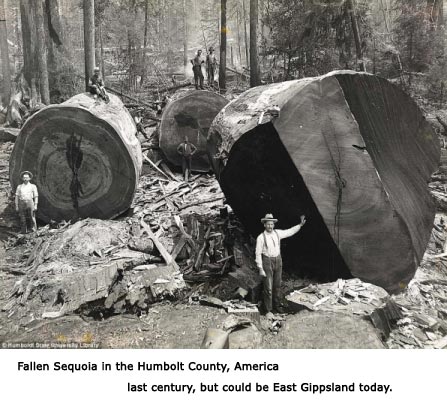 And to all the DSE and VicForests ghost-readers of our E-Bulletins, we’d like to thanks you for offering us an endless variety of potential legal cases to take you to court on. Please feel free to ping these updates around to your networks. All past E Bulletins are available on our website - click here A Question: Good News
1. Simple things you can do. placesyoulove.org Sign the petition urging Julia Gillard to strengthen, not weaken Federal environment laws. Nippon Paper Group: Please stop using woodchips from native forest - Sign the Petition! Sign this one to urge Nippon Paper to move into plantations and get out of our native forest. http://www.gofundme.com/18g0js This is the site to donate for an important legal case for the Glossy Black Cockatoo and similar species. See the article below for more details. 2. Gunns – there endeth an era  After about 140 years of logging almost anything in its sights, the last few years has seen it looking down its own barrel. Much to millions of Australian’s delight, it finally admitted defeat recently and declared insolvency.
After about 140 years of logging almost anything in its sights, the last few years has seen it looking down its own barrel. Much to millions of Australian’s delight, it finally admitted defeat recently and declared insolvency.
Gunns historyGunns started as a small Launceston sawmilling business in 1875. By 1986 it was a publicly listed company. In 1999 Gunns began to swallow up Boral in Tasmania and Tasmania’s biggest woodchip company, North Forest Products. It has since been responsible for untold destruction of ancient forests and wildlife, converting most of it into pulpwood crops.By 2004 Gunns employed about 1,200 people, was worth about $1 billion and had a share price of $4.46. It wielded immense political power in the Apple Isle, being given millions in public funds to help its operations along. It sued conservationists to silence them and threw its weight around relentlessly. The end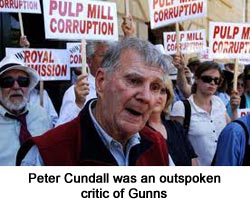 Its controversial plan for a $2.3 billion pulp mill in the Tamar Valley was the beginning of its downfall. Environment groups and world trends convinced it that to gain the markets it wanted for its products, it needed to run on ethically obtained wood. It moved into plantations. But other forces were at work and despite desperate attempts to hang on, it finally had to admit defeat and on the 25th September 2012, it went into voluntary administration – broke and in debt.
Its controversial plan for a $2.3 billion pulp mill in the Tamar Valley was the beginning of its downfall. Environment groups and world trends convinced it that to gain the markets it wanted for its products, it needed to run on ethically obtained wood. It moved into plantations. But other forces were at work and despite desperate attempts to hang on, it finally had to admit defeat and on the 25th September 2012, it went into voluntary administration – broke and in debt.
With a share price of 16c there’s little hope of investors getting their money back. This sends a fairly unambiguous message to others in the logging industry and to banks who finance them, that native forest logging is in a very frail state and is a bad investment. The best article on this so far has been written by Tassie journalist Richard Flanagan. "...the mill is dead—legally in limbo, socially unacceptable, politically impossible, and commercially fantastical. Its end ought to mark the possibility of a new beginning for Tasmania when the state can seek to address its many problems with many solutions free of the bitter divisions Gunns promoted and prospered from. The death of the mill should be a source of hope, not despair." Click here to read the full story. There is also a great analysis of the woodchip industry and its economic history by Dr. Judith Ajani on The Conversation. Worth a read too - http://theconversation.edu.au/the-untold-story-of-the-role-of-government-in-the-rise-and-fall-of-gunns 3. Woodchipping - it’s never been more precarious. The financial situation of the SE NSW and E Gippsland woodchipping industry has recently seen some interesting changes:
 In response, the logging/woodchipping industry is now pushing for native forests to be burnt for electricity as ‘renewable energy’ and to gain subsidies. This is a major part of their five year plan to maintain logging operations and profits.
In response, the logging/woodchipping industry is now pushing for native forests to be burnt for electricity as ‘renewable energy’ and to gain subsidies. This is a major part of their five year plan to maintain logging operations and profits.The ABC reported on 28 September that the CFMEU warned the move could have dire implications for the entire timber industry. As sawmills are not permitted to burn their waste products sawmills are going to be squeezed without a market for their waste wood. Also – the Bega Cheese factory has been burning sawdust from the chipmill to generate power for several years. Recently they have installed a gas fired power generator saying, "With the logging industry under threat of cutbacks, having this secondary boiler would also reduce the risk of running out of fuel," he said. So, it is not just the CFMEU who is talking about the possibility of the chipmill closing. 4. The law of Ecocide and Mother Earth Law The UK Greens Party believes a new Ecocide law is needed and will lead to government policies which put people and planet first. A motion recently passed was: The Green Party of England and Wales gives its wholehearted support for an international law of Ecocide - a crime against nature, humanity and future generations – to be established and recognised as an International Crime Against Peace. To gain support by a UK political party indicates what is possible worldwide. A law of Ecocide is a law that speaks to all parties and people who put people and planet first. Yes - wow! And look at this incredibly progressive law as well … Bolivia passes the world's first laws granting all nature equal rights to humans. The country, which has been pilloried by the US and Britain in the UN climate talks for demanding steep carbon emission cuts, will establish 11 new rights for nature. They include: the right to life and to exist; the right to continue vital cycles and processes free from human alteration; the right to pure water and clean air; the right to balance; the right not to be polluted; and the right to not have cellular structure modified or genetically altered. The Law of Mother Earth, now agreed by politicians and grassroots social groups, redefines the country's rich mineral deposits as "blessings" and is expected to lead to radical new conservation and social measures to reduce pollution and control industry. Controversially, it will also enshrine the right of nature "to not be affected by mega-infrastructure and development projects that affect the balance of ecosystems and the local inhabitant communities". 5. A genuine Australian recycled paper The Nippon owned pulp and paper plant at Maryvale, Australian Paper, recently announced (10th October) a new recycled paper plant to be built on their LaTrobe Valley site. However it’s been silent about getting out of the Central Highland’s native forests. Production is expected to start in early 2014, so won’t be in time save the Leadbeaters possum from VicForests’ determined onslaught. The Federal Govt has promised to pay $9.5 million of its $90 million establishment costs. Nippon plans to transport waste paper from Melbourne, SA and NSW. If this is financially viable, you have to wonder why they can’t also transport plantation eucalypt logs from western Victoria as well. 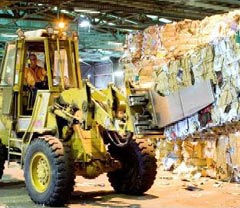
So what % of their production might this be? The media release says it will generate 50,000 tonnes of premium recycled pulp each year. That’s about 10% of the Maryvale mill’s native forest woodchip pulp. It says it’ll be able to supply three times the current market for recycled paper in Australia. So they’ll have to do some serious promotion of it, turn a lot of this into packaging or other recycled products, or even export it. In which case, it wouldn’t do much for forest protection. Consider that ABARE figures show that printing and writing paper has halved since 2007 in Australia, and we find this new move rather curious. BTW - the fastest growing export item out of Port Botany is waste paper to China. Sydney Morning Herald 29/9/12 6. Wood you pay? A logging mole reckons ForestWorks, the union-heavy body that advises the feds on logging industry needs, is struggling to get people to its two-day $1200 a head conference in Canberra's Hyatt Hotel. Last year's conference was wall-to-wall CFMEU members to make up numbers. This year’s $1200 price tag has turned off the forestry industry, as they count their pennies. ForestWorks’ first solution was to turn the price tag into a two-for-one ticket. They are now running around the industry offering to waive the door price and add a $500 cash inducement to industry members willing to attend and wear an 'ambassador' label. Crikey 25/9/12 7. Baillieu and his troops on the nose There is an obvious black hole where the Baillieu government should have an environment policy. It was apparently binned a week before the 2010 state election, then never saw the light of day at the May budget. It’s still missing. We know they prefer to pander to the exploiters like the Mountain cowboys (a much better term than ‘cattle-men’), duck shooters, developers and loggers, but what about their traditional voters in the towns and ‘burbs? Peter Ryan and his nationals must have convinced Ted that their faithful voters don’t care for trees and clean water. But that theory is starting to hurt them. Gary Blackwood MP represents the logging industry. He’s been pushing to change the law on threatened species protection because these pesky things are supposedly costing VicForests time and money and impeding rampant clearfelling of valuable areas. Such a move would deliver them a body blow in marginal seats – and even see a few cranky voters outraged in their blue ribbon seats as well. 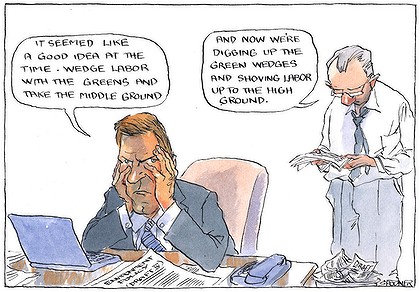 8. $80 billion investment in Natural Capital 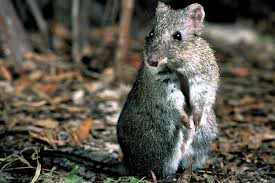 Governments need to spend $US80 billion a year to halt extinctions of endangered animals and plants, 10 times current levels and only half the amount paid to bankers in bonuses last year, a study showed.
Governments need to spend $US80 billion a year to halt extinctions of endangered animals and plants, 10 times current levels and only half the amount paid to bankers in bonuses last year, a study showed.The UN’s 2020 goals (agreed by governments in 2010) for preserving everything from insects to whales would cost $80 billion. This is:
Read more: www.theage.com.au/environment/conservation/conservation efforts need to rise 10 fold to succeed report finds 12/10/12 9. Cutting Green tape This is the most diabolical move against the environment in over 30 years. The Business Council of Australia has written a new policy for the Federal Government to sign, handing the states what used to be the Australian Government’s legal responsibilities for the environment. In December this year The Council of Australian Governments (COAG) will meet with the Federal government to present this new plan and decide on whether to give over most environmental responsibilities and powers to the states, previously overseen by the Commonwealth government. It’s claimed this is part of cutting 'Green Tape' to assist developers, miners and logging interests. The government has already released a plan to amend the EPBC Act to make environmental demolition easier. The states have clearly shown that they are more likely to prioritize short term profits and political interests over the environment. They don’t care for bigger pictures or long term impacts. Please make sure that the Gillard government gets the message loud and clear that Australians want the commonwealth government to be the body that makes the decisions on all matters of environmental significance, and that the EPBC act needs to be strengthened, not weakened. Visit the 'Places You Love' website. placesyoulove.org There is a simple on-line petition – PLEASE CAN YOU SIGN IT - but letters and emails are always more personal and weighty. Please send this around to friends, family and networks. There is a lot of useful material here (PDF) and talking points for letter writing here (PDF) Let's flood the PM, Minister Burke and local MPs with letters and emails. 10. Green tape – costing less than 0.1% of investments The Business Council of Australia (BCA) is claiming that adhering to commonwealth environmental laws costs it dearly – between $270 and $820 million over the life of the EPBC Act (2000-2009). This is why the laws need to go they say. But let’s put that in context … To quote from the BCA’s own report - “there are around $900 billion of committed and prospective investment opportunities in large … scale projects, mostly in resources and economic infrastructure”. This represent just 0.03% to 0.09% of the value of the current investment pipeline for large…scale projects in Australia. Economists-at-Large Report available here (PDF) Tuppence a tonne – States to control our environment?  “The number of threatened species has nearly tripled in the last twenty years”
“The number of threatened species has nearly tripled in the last twenty years”
Our national environment laws have never been particularly strong. While the Business Council of Australia has protested that these laws are too onerous, the big picture tells a far different story. The five-yearly State of the Environment Report clearly shows that we continue to go backwards in the battle for Australia's environment. Our carbon pollution continues to rise, as does the impact of climate change. The number of threatened species has nearly tripled in the last twenty years, and we are losing more and more precious habitat to mining, logging and other development. Read more here 11. Council elections – East Gippsland  For those who vote in the East Gippy Council elections; EEG and our sister group GEG sent 10 environment questions to the 17 wanna-be Councillors.
Only two had the courtesy of replying before the deadline; Bill Gamble and Peter Giddings, with fairly good answers. Then Peter Gardiner replied late.
For those who vote in the East Gippy Council elections; EEG and our sister group GEG sent 10 environment questions to the 17 wanna-be Councillors.
Only two had the courtesy of replying before the deadline; Bill Gamble and Peter Giddings, with fairly good answers. Then Peter Gardiner replied late.
The others obviously don't give a stuff. However, the Friends of Mallacoota had a bit more success and the responses are fairly well reflective of their general attitude to the environment. They asked: “Do you support an ocean access development for Mallacoota's Bastion Point that has majority support, is supported by the Department of Transport, has a lower impact and will cost considerably less to construct, operate and maintain than Council's proposal known as Option 3b?” Giddings, Peter Yes Gamble, Bill Yes Gardner, Peter Yes Wagner, Jeanette Yes Nettleton, Robert Would support if safety requirements are met Ellis, Dick Declared conflict of interest Reeves, Mark Did not wish to or unable to comment Jeffs, Daryl Did not wish to or unable to comment Wilkin, John Did not wish to or unable to comment Neal, Peter Did not wish to or unable to comment McNeil, Jeff Did not wish to or unable to comment Findlay-James, Pearl Did not wish to or unable to comment Pelz, Marianne No Buckley, Ben No Freshwater, Michael No Rowe, Jane No response Anderson, Trudy No response If you’d like to help Bastion Point close to a final decision, please go to: Save_Bastion_Point_Mallacoota_Victoria_Australia_from_inappropriate_development 12. Baillieu – to weaken land clearing laws As if the list of environmental problems that Victoria’s government is exacerbating isn’t enough, it is now planning to alter the native vegetation controls. Subservient to property developers and the farming lobby, this government is reviewing current controls on private land clearing. Review of native vegetation regulations. It’s designed for a reduced public service (called ‘streamlining’) and to save big business money. 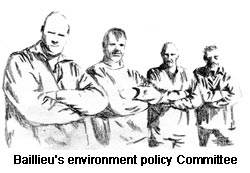 The review was being undertaken behind closed doors before 36 conservation groups made a joint statement in April this year. The government is now asking for public engagement on these changes.
The review was being undertaken behind closed doors before 36 conservation groups made a joint statement in April this year. The government is now asking for public engagement on these changes.
There is every chance a new system will deliver a giant step backwards for native vegetation and habitat on private land. The VNPA is urging individuals and groups to have a say on this review. You’ll find additional briefing papers, link to the review and a guide to assist in writing a submission is provided on the VNPA website here The deadline for submissions is today, Friday 19th October. 13. Deadly mercury levels in the Gippsland Lakes Back in 1980, the government was given a report on heavy metals and mercury in the Gippsland Lakes. The mercury in sediment was significantly higher than in other parts of the world. No action was taken on the report’s recommendations. The main historic sources being: Goldmining (76tonne); Australian Paper Mill (14tonne) and coal fired power stations (40tonne). These have a continuing input of more than 2 tonnes per annum into the lakes’ catchments. In 1998 Gippsland Coastal Board retained the CSIRO to review the water quality of the Gippsland Lakes. The Audit reported that; “The mercury problem does require further investigation, as the evidence indicates rising mercury levels in fish; and sediment concentrations are approaching alarmingly high levels”. And “Further investigation and research on mercury sources, sinks and cycling is required to enable more effective management of what might be a public health problem”. Again no action was taken by responsible authorities. 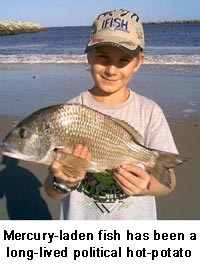 In 1999 a study was published by Fabris titled “Mercury and organochlorins in black bream; Gippsland Lakes”. It stated:
In 1999 a study was published by Fabris titled “Mercury and organochlorins in black bream; Gippsland Lakes”. It stated: “The main concentration of mercury in black bream is now 58% higher than that recorded in 1978”. In 2007, nine dolphins were reported to have died of mercury poisoning. Another seven dolphins are known to have since died. The total dolphin deaths are now approximately 30% of the lakes dolphin population, considered to be around 50 and recently identified as a new species. The risk of mercury exposure during pregnancy is of great concern because the unborn baby is particularly vulnerable to brain damage and various other health related issues from the toxic effects of mercury. The results of these studies highlight very serious human health risks, and it is of concern that the recommendations to conduct further investigation have been ignored. We wait to see if the new Ministerial Advisory Committee will have the resources and commitment to tackle this problem. http://geg.org.au 14. Tassie – still run by loggers Forestry Tasmania (like our VicForests) has just bought itself a stake in ongoing forest destruction. It secretly purchased (with public money!) the big Southwood Sawmill and its 40,000 m3 sawlog licence! Not to retire the sawlog quota and so protect forests, but to demand it be honoured and so stymie forest protection and the negotiations. The big industry/green pow-wow that’s been going on down in Tassie for what seems like donkey’s years, is still unable to reach an agreement on forest protection. From the outside looking in, it appears that the Tasmanian government and logging interests are carrying out classic stalling tactics, all the while continuing to clearfell controversial forests. At the same time, they demand green groups not protest or hold markets campaigns against their products. The logging interests have spat their dummies and walked out more times than we can count. If there is a final agreement, green groups want to see about 500,000 ha protected and a number of other things like a promise of no biomass production from forests. Forestry Tasmania says they can’t protect all that forest because they can’t meet their licence commitments to mills. Well not now they’ve just bought one of those mills to demand it be fed. Time to pull the pin on this process and go back to protests and market campaigns we think. Jill/Huon Valley Environment Centre 16/10/12 15. Korea and Japan looking for wood – to burn The combined environment movement could make life very uncomfortable for energy retailers that sell customers electricity which has been generated from burning native forest wood. But it would be a trickier campaign to prevent the shipment of wood pellets to power companies in Korea and Japan. These countries are gearing up for biomass burning to produce electricity. And our logging industry is giving them the serious come-on. www.troymedia.com/2012/09/29/south-korea-and-japan-set-to-become-large-importers-of-pellets-and-energy-chips/ 16. VicForests – chronic welfare bludgers The 8th VicForests Annual Report was tabled in Parliament in mid September (2012). Guess what - they made another loss. This means VicForests has lost around $24 million over the past 8 years – and owe the state (you and I) between $40-60 million in unpaid dividends. This year, VicForests is dressing up the loss with a new set of excuses. The argument that the bushfires are to blame has worn thin. Their latest excuses include those who dare to take them to court. The losses were attributed to:
VicForests employs 120 people statewide, but it’d be cheaper to send every one of them to Bali to retire than to keep paying them to obliterate public forests. This semi-corporate entity was set up eight years ago with the purpose of becoming an economically viable business. Year after year it makes spectacular losses. Ted Baillieu is happy to hand them millions more while sacking 400-500 staff in DPI and DSE, and looking for panthers. Monty Python move over! This analysis by MyEnvironment shows that VicForests owes the people of Victoria at least $40-60 million in unpaid dividends for the ‘privilege’ of exploiting public forests. But VicForests say they are on the road to recovery – which sounds like something an alcoholic would say. From 2009/10 to 2010/11 they had a 13% drop in sawlog sales. This year the drop was 11% all up. From 2009/10 to 2010/11, they had a 7% drop in woodchip log sales. This year the drop was 16%. So blaming the Heyfield mill is just a handy excuse. Their main problem is that they can’t find major buyers for woodchip logs. 17. VicForests destroys rare Cockatoo habitat. The dust has barely settled on the Brown Mountain legal case and VicForests is at it again. While the Gliders and Potoroos remain in an uneasy limbo during this current ceasefire at Brown Mountain, habitat of rare wildlife elsewhere is copping reckless demolition. 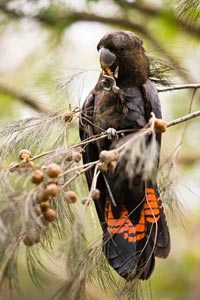 The threatened Glossy Black Cockatoo of the far east forests around Genoa and Mallacoota have had the bulldozer and burn treatment. This was despite VicForests’ wildlife surveys (as the court ordered) finding rare species in these forests.
The threatened Glossy Black Cockatoo of the far east forests around Genoa and Mallacoota have had the bulldozer and burn treatment. This was despite VicForests’ wildlife surveys (as the court ordered) finding rare species in these forests.
The Glossy Black Cockatoo is threatened by logging and burning. This friendly parrot only exists in Victoria’s far east and relies totally on mature casuarina trees for its food and old growth trees for nesting hollows - hence its rarity. It’s recognised as being threatened under the Flora and Fauna Guarantee Act. No one knows how many survive in Victoria – maybe as few as 200. How does VicForests justify destroying hundreds of hectares of its prime habitat? It claims that as there is no Action Statement (‘how-to-protect’ instructions), they aren’t obliged to protect it. This is despite it being recognised as threatened by Victorian legislation.  Other wildlife that probably shared these recently destroyed forests with the ‘Glossy’ could have been the slow-moving and non-venomous Diamond Python, also threatened and very vulnerable to logging and prescribed burns. This is listed and DOES have an Action Statement to describe protection measures, but of course is difficult to find.
Other wildlife that probably shared these recently destroyed forests with the ‘Glossy’ could have been the slow-moving and non-venomous Diamond Python, also threatened and very vulnerable to logging and prescribed burns. This is listed and DOES have an Action Statement to describe protection measures, but of course is difficult to find.
We will send you more details as our legal team looks into this one. But a $10 or $50 donation can be made easily via GoFundMe, www.gofundme.com/18g0js or via the GiveNow page (here) or directly into the Environment East Gippsland account. Email us (here) for the details and we can send a tax deductible receipt. If/when we proceed with this case it is expected to be much cheaper and more straightforward than the Brown Mountain case. 18. VicForests - student project is factual 'science’  In the last update we mentioned that VicForests has claiming they had completed a "study" that found that native animals could use logged areas for habitat. We’ve shown that it was little more than a minimal student project.
In the last update we mentioned that VicForests has claiming they had completed a "study" that found that native animals could use logged areas for habitat. We’ve shown that it was little more than a minimal student project.
When a member tried to obtain a copy of this report from Melbourne University, they were told that the report couldn't be released because it was "just a student's report that is preliminary in nature and hasn't been peer reviewed". This report is touted in VicForests’ Annual Report as a "Masters Thesis", and completely misrepresents the work. VicForests steadfastly refuses to amend their report. They claim that they only described it as a Masters thesis "in order to simplify the language". So what’s so complex about the language of “a student's project report”? Their Annual Report presented to Parliament also falsely claims that the study "found that a range of different faunal groups are using regenerating forest as habitat". In fact, the study only looked for six ground mammals using automatic cameras. There are no results for amphibians, reptiles, birds, bats, insects or arboreal marsupials. The logged sites were all next to mature unlogged forest, so it is not surprising that some ground mammals wandered into the regenerating stands. But this does not mean that regrowth is providing "habitat". This was made clear in an email sent by Melbourne University to one of our members: "What the data don't show is how the animals were using these areas. We need more research to answer that question". Apart from the fact that the study was done in East Gippsland, nothing VicForests told Parliament about this project in its Annual Report is correct.
Jill and the team.  |